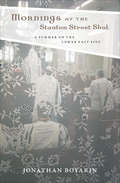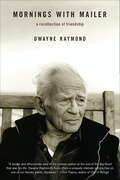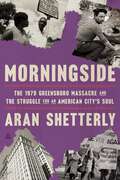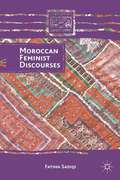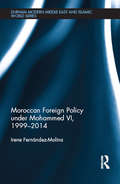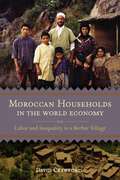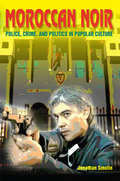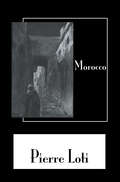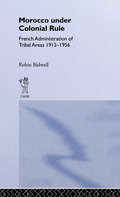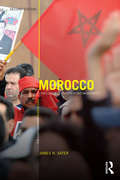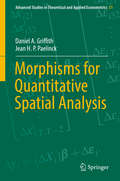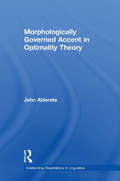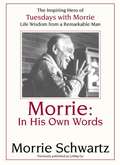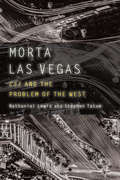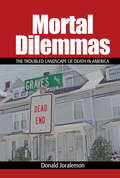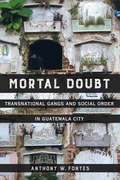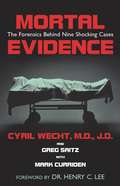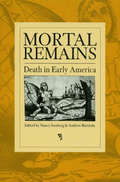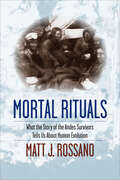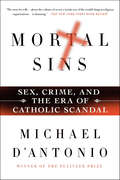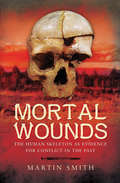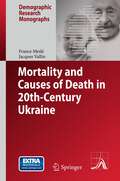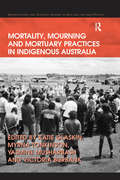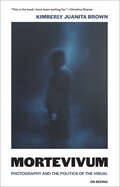- Table View
- List View
Morning, Noon, and Night: Finding the Meaning of Life's Stages Through Books
by Arnold WeinsteinFrom Homer and Shakespeare to Toni Morrison and Jonathan Safran Foer, major works of literature have a great deal to teach us about two of life's most significant stages--growing up and growing old. Distinguised scholar Arnold Weinstein's provocative and engaging new book, Morning, Noon, and Night, explores classic writing's insights into coming-of-age and surrendering to time, and considers the impact of these revelations upon our lives. With wisdom, humor, and moving personal observations, Weinstein leads us to look deep inside ourselves and these great books, to see how we can use art as both mirror and guide. He offers incisive readings of seminal novels about childhood-Huck Finn's empathy for the runaway slave Jim illuminates a child's moral education; Catherine and Heathcliff's struggle with obsessive passion in Wuthering Heights is hauntingly familiar to many young lovers; Dickens's Pip, in Great Expectations, must grapple with a world that wishes him harm; and in Marjane Satrapi's autobiographical Persepolis, little Marjane faces a different kind of struggle--growing into adolescence as her country moves through the pain of the Iranian Revolution. In turn, great writers also ponder the lessons learned in life's twilight years: both King Lear and Willy Loman suffer as their patriarchal authority collapses and death creeps up; Brecht's Mother Courage displays the inspiring indomitability of an aging woman who has "borne every possible blow... but is still standing, still moving." And older love can sometimes be funny (Rip Van Winkle conveniently sleeps right through his marriage) and sometimes tragic (as J. M. Coetzee's David Lurie learns the hard way, in Disgrace). Tapping into the hearts and minds of memorable characters, from Sophocles' Oedipus to Artie in Art Spiegelman's Maus, Morning, Noon, and Night makes an eloquent and powerful case for the role of great literature as a knowing window into our lives and times. Its intelligence, passion, and genuine appreciation for the written word remind us just how crucial books are to the business of being human.
Mornings at the Stanton Street Shul: A Summer on the Lower East Side
by Jonathan BoyarinThis story of one of the last remaining synagogues in the historic neighborhood and its congregation is &“as absorbing as a good cinema verité documentary&” (Booklist). On New York&’s Lower East Side, a narrow building, wedged into a lot designed for an old-law tenement, is full of clamorous voices—the generations of the dead, who somehow contrive to make their presence known, and the newer generation, keeping the building and its memories alive and making themselves Jews in the process. In this book, Jonathan Boyarin, at once a member of the congregation and a bemused anthropologist, follows this congregation of &“year-round Jews&” through the course of a summer during which its future must once again be decided. Famous as the jumping off point for millions of Jewish and other immigrants to America, the neighborhood has recently become the hip playground of twentysomething immigrants to the city from elsewhere in America and from abroad. Few imagine that Jewish life there has stubbornly continued through this history of decline and regeneration. Yet, inside with Boyarin, we see the congregation&’s life as a combination of quiet heroism, ironic humor, lively disputes, and—above all—the ongoing search for ways to connect with Jewish ancestors while remaining true to oneself in the present. Mornings at the Stanton Street Shul is both a portrait of a historic neighborhood facing the challenges of gentrification, and a poignant, humorous chronicle of vibrant, imperfect, down-to-earth individuals coming together to make a community.
Mornings with Mailer: A Recollection of Friendship
by Dwayne Raymond“Mornings with Mailer is a tender and affectionate view of the protean author at the end of the Big Novel that was his life. Dwayne Raymond’s book offers a uniquely intimate perspective on one of our literary giants. Applause.” — Tom Piazza, author of City of Refuge“In this moving memoir, Dwayne Raymond provides an intimate look at the daily routine of a great writer in the last years of his life.” — Doris Kearns Goodwin, Pulitzer Prize-winning author of Team of Rivals Mornings with Mailer is the revealing memoir by Dwayne Raymond, the man who worked as Norman Mailer’s personal assistant during the last five years of the iconic author’s life. Recasting the legendary writer of such classics as The Naked and the Dead and The Executioner’s Song in a new light, Mornings with Mailer describes the powerful bond that formed between him and Raymond from April 2003 until Mailer’s death in November 2007.
Morningside: The 1979 Greensboro Massacre and the Struggle for an American City's Soul
by Aran ShetterlyAn unflinching look at the all but forgotten though no less shocking 1979 racial tragedy that divided Greensboro, N.C., and the nation, and the grassroots activists who, in their tireless fight for justice, refused to give up on America’s promised ideals.On November 3, 1979, as activist Nelson Johnson assembled people for a march adjacent to Morningside Homes in Greensboro, North Carolina, gunshots rang out. A caravan of Klansmen and Neo-Nazis sped from the scene, leaving behind five dead. Known as the “Greensboro Massacre,” the event and its aftermath encapsulate the racial conflict, economic anxiety, clash of ideologies, and toxic mix of corruption and conspiracy that roiled American democracy then—and threaten it today.In 88 seconds, one Southern city shattered over irreconcilable visions of America’s past and future. When the shooters are acquitted in the courts, Reverend Johnson, his wife Joyce, and their allies, at odds with the police and the Greensboro establishment, sought alternative forms of justice. As the Johnsons rebuilt their lives after 1979, they found inspiration in Nelson Mandela’s post-apartheid Truth and Reconciliation Commission and Martin Luther King Jr’s concept of Beloved Community and insist that only by facing history’s hardest truths can healing come to the city they refuse to give up on.This intimate, deeply researched, and heart-stopping account draws upon survivor interviews, court documents, and the files from one of the largest investigations in FBI history. The persistent mysteries of the case touch deep cultural insecurities and contradictions about race and class. A quintessentially American story, Morningside explores the courage required to make change and the evolving pursuit of a more inclusive and equal future.
Moroccan Feminist Discourses
by Fatima SadiqiThis book is both scholarly and personal. It is scholarly because it addresses and assesses the current Moroccan feminist discourses, a topic the author has been involved with for almost three decades, and it is personal because it brings along her Berber identity and seeks to reposition it vis-a-vis these feminist discourses. Revisiting the Moroccan feminist discourses in the aftermath of the uprisings in the region which, among other things, brought about the spectacular change in the political status of Berber from an indigenous centuries-long marginalized language to an 'official language' of Morocco came with serious challenges to the feminist discourses by highlighting the stark absence of Berber, a women-related language, in these discourses. The two recognized types of feminist discourse, the secular and Islamic ones, are not only divergent but suffer from a shortage in scope and discard the rich heritage, knowledge, and art that Berber women bring along to the Moroccan feminist discourses. "
Moroccan Foreign Policy under Mohammed VI, 1999-2014 (Durham Modern Middle East and Islamic World Series)
by Irene Fernandez-MolinaThis book presents a comprehensive survey of Moroccan foreign policy since 1999. It considers the objectives, actors and decision-making processes involved, and outlines Morocco's foreign policy activity in key areas such as the international management of the Western Sahara conflict and relations with the other states of North Africa, relations with the European Union, especially France and Spain, and relations with the United States and the Middle East. <P><P>The book links the behaviour and discourses analysed to differing conceptions of Morocco's national role on the international scene - champion of national territorial integrity, model student of the EU, and good ally of the United States - and shows how these competing approaches to the country's foreign policy enjoy different degrees of domestic consensus, and result in different degrees of legitimation for the regime.
Moroccan Households in the World Economy: Labor and Inequality in a Berber Village
by David CrawfordIn the High Atlas Mountains of Morocco, far from the hustle and noise of urban centers, lies a village made of mud and rock, barely discernible from the surrounding landscape. Yet a closer look reveals a carefully planned community of homes nestled above the trees, where rock slides are least frequent, and steep terraces of barley fields situated just above spring flood level. The Berber-speaking Muslims who live and farm on these precipitous mountainsides work together at the arduous task of irrigating the fields during the dry season, continuing a long tradition of managing land, labor, and other essential resources collectively. In Moroccan Households in the World Economy, David Crawford provides a detailed study of the rhythms of highland Berber life, from the daily routines of making a living in such a demanding environment to the relationships between individuals, the community, and the national economy. Demonstrating a remarkably complete understanding of every household and person in the village, Crawford traces the intricacies of cooperation between households over time. Employing a calculus known as "arranging the bones," villagers attempt to balance inequality over the long term by accounting for fluctuations in the needs and capacities of each person, household, and family at different stages in its history. Tradition dictates that children "owe" labor to their parents and grandparents as long as they live, and fathers decide when and where the children in their household work. Some may be asked to work for distant religious lodges or urban relatives they haven't met because of a promise made by long-dead ancestors. Others must migrate to cities to work as wage laborers and send their earnings home to support their rural households. While men and women leave their community to work, Morocco and the wider world come to the village in the form of administrators, development agents, and those representing commercial interests, all with their own agendas and senses of time. Integrating a classic village-level study that nevertheless engages with the realities of contemporary migration, Crawford succinctly summarizes common perceptions and misperceptions about the community while providing a salient critique of the global expansion of capital. In this beautifully observed ethnography, Crawford challenges assumptions about how Western economic processes transfer to other contexts and pulls the reader into an exotic world of smoke-filled kitchens, dirt-floored rooms, and communal rooftop meals -- a world every bit as fascinating as it is instructive.
Moroccan Noir
by Jonathan SmolinFacing rising demands for human rights and the rule of law, the Moroccan state fostered new mass media and cultivated more positive images of the police, once the symbol of state repression, reinventing the relationship between citizen and state for a new era. Jonathan Smolin examines popular culture and mass media to understand the changing nature of authoritarianism in Morocco over the past two decades. Using neglected Arabic sources including crime tabloids, television movies, true-crime journalism, and police advertising, Smolin sheds new light on politics and popular culture in the Middle East and North Africa.
Morocco
by Pierre LotiFirst Published in 2002. Pierre Loti was a member of a diplomatic mission to the Sultan of Morocco at Fez, and in this book he gives us an extraordinarily fascinating account of the journey. The departure of the caravan from Tangier, the encampments, the nightly arrival of the Mouna, the crossing of the Oued-M'Cazen in flood, the fantasies and 'powder-play' of the Arab horsemen, and the magnificent state entry into Fez, are described in a succession of vivid vignettes.
Morocco Under Colonial Rule: French Administration of Tribal Areas 1912-1956
by Robin BidwellThis evaluation of the work of a colonial administration uses an analysis of the policies employed in the fields of education, administration, justice and agriculture. It shows how a largely archaic and isolated country transformed itself and its relationship with the western world.
Morocco: Challenges to tradition and modernity (The Contemporary Middle East)
by James N. SaterThe first edition of Morocco was published one year before the mass protests of the Arab Spring rocked the Moroccan state. Post-Arab Spring, the country has a new constitution and government, but the state remains uncompromising on any true reform of the monarchy’s claims to power. This new edition provides an introductory overview of the history, contemporary politics, economy, and international relations in Morocco and offers an examination of the challenges to tradition and modernity in the post-colonial state. It has been revised and updated to include analysis of the country’s evolving politics in the years following the Arab Spring, and the consequences this has had for the country’s traditional monarchy. It pays particular attention to the new constitution, the policies of the new Islamist-led government, and it includes an analysis of Morocco’s foreign policy in the post-Arab Spring regional context. Drawing on key academic texts, the author provides a detailed analysis of Morocco, focusing on issues such as: • Morocco’s role within the region • Trade policies with Europe • Migration • Morocco’s Western Sahara policy • Ways of dealing with Political Islam • The extent to which European influence has affected Moroccan society Easily accessible to non-specialists, practitioners, and upper level undergraduate students, the book will be essential reading for those working in the fields of North African studies, International Relations and Middle East studies.
Morphisms for Quantitative Spatial Analysis (Advanced Studies In Theoretical And Applied Econometrics Ser. #51)
by Daniel A. Griffith Jean H. PaelinckThis book treats the notion of morphisms in spatial analysis, paralleling these concepts in spatial statistics (Part I) and spatial econometrics (Part II). The principal concept is morphism (e.g., isomorphisms, homomorphisms, and allomorphisms), which is defined as a structure preserving the functional linkage between mathematical properties or operations in spatial statistics and spatial econometrics, among other disciplines. The purpose of this book is to present selected conceptions in both domains that are structurally the same, even though their labelling and the notation for their elements may differ. As the approaches presented here are applied to empirical materials in geography and economics, the book will also be of interest to scholars of regional science, quantitative geography and the geospatial sciences. It is a follow-up to the book “Non-standard Spatial Statistics and Spatial Econometrics” by the same authors, which was published by Springer in 2011.
Morphologically Governed Accent in Optimality Theory (Outstanding Dissertations in Linguistics)
by John D. AldereteAlderete examines the influences of morphological factors on stress and pitch accent within Optimality Theory.
Morrie: In His Own Words
by Morrie SchwartzFrom the book: In these remarkable pages are the profound, life-affirming words of Morrie Schwartz (the hero of Tuesdays with Morrie) as he faced his own imminent death. In 1994, at the age of seventy-seven, Schwartz learned he had A L S, commonly known as Lou Gehrig's disease. Undaunted, the former professor embraced his illness, choosing to live passionately and calmly until the end. He also embarked on his greatest teaching adventure: sharing his evolving knowledge of living while dying. With warmth, wisdom, and humor, Morrie reveals how to...live fully in the moment...tap into the powers of the mind to transcend physical limitations...grieve for your losses...reach out to family and friends... develop an inner space for meditation and spiritual connection. It's never too late to become the kind of person you'd like to be. Morrie shows the way in his magnificent legacy of love, forgiveness, transcendence, and redemption, a guide to living fully to the end of your days.
Morta Las Vegas: CSI and the Problem of the West (Postwestern Horizons)
by Nathaniel Lewis Stephen TatumThrough all its transformations and reinventions over the past century, “Sin City” has consistently been regarded by artists and cultural critics as expressing in purest form, for better or worse, an aesthetic and social order spawned by neon signs and institutionalized indulgence. In other words, Las Vegas provides a codex with which to confront the problems of the West and to track the people, materials, ideas, and virtual images that constitute postregional space.Morta Las Vegas considers Las Vegas and the problem of regional identity in the American West through a case study of a single episode of the television crime drama CSI: Crime Scene Investigation. Delving deep into the interwoven events of the episode titled “4 × 4,” but resisting a linear, logical case-study approach, the authors draw connections between the city—a layered and complex world—and the violent, uncanny mysteries of a crime scene. Morta Las Vegas reveals nuanced issues characterizing the emergence of a postregional West, moving back and forth between a geographical and a procedural site and into a place both in between and beyond Western identity.
Mortal Dilemmas: The Troubled Landscape of Death in America
by Donald JoralemonAnthropologist Donald Joralemon asks whether America is really, as many scholars claim, a death-denying culture that prefers to quarantine the sick in hospitals and the elderly in nursing homes. His answer is a reasoned “no.” In his view, Americans are merely struggling to find cultural scripts for the exceptional conditions of dying that our social world and medical technologies have thrust upon us. The book: is written in the first-person for a broad audience by a senior anthropologist, making it an authoritative yet accessible textbook for courses on death and dying and American culture; includes contemporary debates about highly visible cases, the definition of death, the status of human remains, aging, and the medicalization of grief; demonstrates persuasively that arguments over death and dying are in fact arguments about what it means to be human in modern America.
Mortal Doubt: Transnational Gangs and Social Order in Guatemala City (Atelier: Ethnographic Inquiry in the Twenty-First Century #1)
by Anthony W. FontesThe fear of violent crime dominates Guatemala City. In the midst of unprecedented levels of postwar violence, Guatemalans struggle to fathom the myriad forces that have made life in this city so deeply insecure. Born out of histories of state terror, migration, and US deportation, maras (transnational gangs) have become the face of this new era of violence. They are brutal organizations engaged in extortion, contract killings, and the drug trade, and yet they have also become essential to the emergence of a certain kind of social order. Drawing on years of fieldwork inside prisons, police precincts, and gang-dominated neighborhoods, Anthony W. Fontes demonstrates how gang violence has become indissoluble from contemporary social imaginaries and how these gangs provide cover for a host of other criminal actors. Ethnographically rich and unflinchingly critical, Mortal Doubt illuminates the maras’ role in making and mooring collective terror in Guatemala City while tracing the ties that bind this violence to those residing in far safer environs.
Mortal Evidence: The Forensics Behind Nine Shocking Cases
by Cyril H. WechtA lifeless newborn baby is found discarded in a motel Dumpster. Authorities quickly arrest the infant's teenage parents, charging them with murder. Did Amy Grossberg and Brian Peterson, in fact, murder their own baby? Tammy Wynette died suddenly at a relatively young age, and yet no autopsy was performed? Was someone trying to hide the real cause of death? Did Sam Sheppard (later dubbed "The Fugitive" based on a television series) really kill his wife? And if not, who committed the murder?Things are not always as they appear, as world-renowned forensic pathologist Dr. Cyril Wecht shows in this riveting behind-the-scenes look at nine famous cases. In the nationally known baby case involving Amy Grossberg and Brian Peterson, Dr. Wecht reviews the evidence and comes to a startling conclusion. In fascinating detail, he demonstrates how the tools of forensic pathology often uncover murky, long-hidden secrets that crack seemingly unsolvable crimes. Writing in the first-person Dr. Wecht leads you into the heart of the investigation, focusing each chapter on a single engrossing drama. He reveals the most startling evidence that shows why JonBenet Ramsey's killer most likely came from within her home, why O.J. Simpson probably had an accomplice in the murder of Nicole Simpson and Ron Goldman, shocking revelations about Robert Berdella's grisly torture and sex-abuse crimes against young men, and many intriguing facts about other infamous cases.If you find the fictional plots of such dramas as C.S.I. exciting, you will be amazed by the true stories told by Dr. Wecht, with the help of two top-flight veteran reporters, Greg Saitz and Mark Curriden, in this amazing real-life thriller. As this intriguing page-turner proves, the science of forensic pathology has changed the face of detective work forever.
Mortal Remains
by Andrew Burstein Nancy IsenbergMortal Remains introduces new methods of analyzing death and its crucial meanings over a 240-year period, from 1620 to 1860, untangling its influence on other forms of cultural expression, from religion and politics to race relations and the nature of war. In this volume historians and literary scholars join forces to explore how, in a medically primitive and politically evolving environment, mortality became an issue that was inseparable from national self-definition.Attempting to make sense of their suffering and loss while imagining a future of cultural permanence and spiritual value, early Americans crafted metaphors of death in particular ways that have shaped the national mythology. As the authors show, the American fascination with murder, dismembered bodies, and scenes of death, the allure of angel sightings, the rural cemetery movement, and the enshrinement of George Washington as a saintly father, constituted a distinct sensibility. Moreover, by exploring the idea of the vanishing Indian and the brutality of slavery, the authors demonstrate how a culture of violence and death had an early effect on the American collective consciousness.Mortal Remains draws on a range of primary sources--from personal diaries and public addresses, satire and accounts of sensational crime--and makes a needed contribution to neglected aspects of cultural history. It illustrates the profound ways in which experiences with death and the imagery associated with it became enmeshed in American society, politics, and culture.
Mortal Rituals: What the Story of the Andes Survivors Tells Us About Human Evolution
by Matt J. RossanoA psychology professor examines what the survivors of the airplane crash hailed &“The Miracle of the Andes&” can show us about human evolution.On December 21, 1972, sixteen young survivors of Uruguayan Air Force Flight 571 were rescued after spending ten weeks stranded at the crash site of their plane, high in the remote Andes Mountains. The incident made international headlines and spawned several best-selling books, fueled partly by the fact that the young men had resorted to cannibalism to survive. Matt Rossano examines this story from an evolutionary perspective, weaving together findings and ideas from anthropology, psychology, religion, and cognitive science. During their ordeal, these young men broke &“civilized&” taboos to fend off starvation and abandoned &“civilized&” modes of thinking to maintain social unity and individual sanity. Through the power of ritual, the survivors were able to endure severe emotional and physical hardship. Rossano ties their story to our story, seeing in the mortal rituals of this struggle for survival a reflection of what it means to be human.&“[Rossano&’s] narrative describes a &“microcosm of human evolution,&” and I think this book will grab the interest of many readers―students as well as the general public―as it teaches essential facts about the way Homo sapiens evolved.&”—David Hicks, Stony Brook University and Clare College, Cambridge University &“[Rossano] masterfully weaves a moving contemporary drama with a compelling account of the evolutionary history of ritual and religion. An impressive accomplishment and a truly captivating read from start to finish.&”—Richard Sosis, University of Connecticut, cofounder and coeditor of Religion, Brain, & Behavior
Mortal Sins: Sex, Crime, and the Era of Catholic Scandal
by Michael D'AntonioA Publishers Weekly Best Nonfiction Book of 2013A Kirkus Reviews Best Book of 2013An Edgar Award for Best Fact Crime NomineeAn explosive, sweeping account of the scandal that has sent the Catholic Church into a tailspin -- and the brave few who fought for justiceIn the mid-1980s a dynamic young monsignor assigned to the Vatican's embassy in Washington set out to investigate the problem of sexually abusive priests. He found a scandal in the making, confirmed by secret files revealing complaints that had been hidden from police and covered up by the Church hierarchy. He also understood that the United States judicial system was eager to punish offenders and those who aided them. He presented all of this to the American bishops, warning that the Church could be devastated by negative publicity and bankrupted by its legal liability. They ignored him.Meanwhile, a young lawyer listened to a new client describe an abusive sexual history with a priest that began when he was ten years old. His parents' complaints were downplayed by Church officials who offered them money to go away. The lawyer saw a claim that any defendant would want to settle. Then he began to suspect he was onto something bigger, involving thousands of priests who had abused countless children while the Church had done almost nothing about it. The lawsuit he filed would touch off a legal war of historic and global proportions.Part history, part journalism, and part true-crime thriller, Michael D'Antonio's Mortal Sins brings to mind landmark books such as All the President's Men, And the Band Played On, and The Informant, as it reveals a long and ferocious battle for the soul of the largest and oldest organization in the world.
Mortal Wounds: The Human Skeleton as Evidence for Conflict in the Past
by Martin SmithA biological anthropologist uses the human skeleton to examine the history of violence from the Mesolithic era to the nineteenth century. Human beings have a violent past. Physical hostilities between people are at least as old as humanity and the roots of such behaviour go very deep. Earlier studies have been based on a range of sources including written documents, as well as archaeological evidence in the form of weapons, armour and defences. However, each of these is fraught with problems and there is in fact only one form of evidence that can both directly testify to past violence and which has also been present throughout the whole human story –the remains of past people themselves. This book brings together a wealth of recently recognised evidence from preserved human skeletons to investigate a range of questions regarding the ways human beings have used violence to achieve their aims, in a single volume presenting this continuous thread of unbroken evidence from the early Stone Age to the 19th century. Who engaged in violence? Who were the victims? How have styles and objectives of conflict changed over time? How old is war and why did it appear when it did? All these and further questions are addressed in this cutting-edge book, the first of its kind to be aimed at the general reader and written for an audience that may not be familiar with what we can learn from the human skeleton about our shared past and the changing face of human conflict.Praise for Mortal Wounds &“This well researched, well written book is recommended for archaeologists, military historians and all those interested in the development of human kind.&” —Minerva &“An excellent introduction to the bioarchaeology of interpersonal conflict. [This book] will likely be of greatest interest to bioarchaeologists, but the thorough explanations and descriptions of concepts and methods make the book accessible to a general, non-specialist audience&” —Classical Journal &“This engaging, well-written, illustrated book introduces readers to a relatively new field within anthropology called &“conflict archaeology.&” . . . The book is aimed at general readers, and Smith avoids jargon whenever possible, clearly defining specialized terms when necessary. The book should also be worthwhile reading for academics with related interests but who lack expertise in skeletal analysis. Summing Up: Highly recommended. All public and academic levels/libraries.&” —Choice
Mortality and Causes of Death in 20th-Century Ukraine
by Jacques Vallin France Meslé Vladimir Shkolnikov Sergei Adamets Serhii PyrozhkovThe Ukraine faced two very different kinds of health crises during the twentieth century. First, in the 1930s and 1940s, famine, war and political upheaval caused massive population losses. Previous evaluations of overall losses have given an idea of the scale of these catastrophes but do not distinguish between crisis mortality, birth shortfall and loss through emigration. Based on a painstaking work of reconstitution, this study is the first to provide a detailed estimation of the hecatomb in terms of number of deaths and life expectancy. The famine of 1933 was alone responsible for the deaths of 2.6 million Ukrainians and reduced male and female life expectancies to 7 and 11 years respectively. Once the crises of the 1930s and 1940s were over, the earlier trend in health resumed and mortality declined steadily until the 1960s. At this point, however, a new type of crisis appeared that caused a sustained reversal in the existing trends. Life expectancy for women stopped increasing altogether, while that for men began a relentless year on year regression. Notwithstanding the confusing picture created by the fluctuations of the 1980s and 1990s, the long-term trend is to further deterioration. To understand the factors involved, this study analyses in detail the combined effects of different causes of death at different ages.
Mortality, Mourning and Mortuary Practices in Indigenous Australia (Anthropology and Cultural History in Asia and the Indo-Pacific)
by Myrna Tonkinson Victoria BurbankDrawing on ethnography of Aboriginal and Torres Strait Islander communities across Australia, Mortality, Mourning and Mortuary Practices in Indigenous Australia focuses on the current ways in which indigenous people confront and manage various aspects of death. The contributors employ their contemporary and long-term anthropological fieldwork with indigenous Australians to construct rich accounts of indigenous practices and beliefs and to engage with questions relating to the frequent experience of death within the context of unprecedented change and premature mortality. The volume makes use of extensive empirical material to address questions of inequality with specific reference to mortality, thus contributing to the anthropology of indigenous Australia whilst attending to its theoretical, methodological and political concerns. As such, it will appeal not only to anthropologists but also to those interested in social inequality, the social and psychosocial consequences of death, and the conceptualization and manipulation of the relationships between the living and the dead.
Mortevivum: Photography and the Politics of the Visual (On Seeing)
by Kimberly Juanita BrownA powerful examination of the unsettling history of photography and its fraught relationship to global antiblackness.Since photography&’s invention, black life has been presented as fraught, short, agonizingly filled with violence, and indifferent to intervention: living death—mortevivum—in a series of still frames that refuse a complex humanity. In Mortevivum, Kimberly Juanita Brown shows us how the visual logic of documentary photography and the cultural legacy of empire have come together to produce the understanding that blackness and suffering—and death—are inextricable. Brown traces this idea from the earliest images of the enslaved to the latest newspaper photographs of black bodies, from the United States and South Africa to Haiti and Rwanda, documenting the enduring, pernicious connection between photography and a global history of antiblackness.Photography's history, inextricably linked to colonialism and white supremacy, is a catalog of othering, surveillance, and the violence of objectification. In the genocide in Rwanda, for instance, photographs after the fact tell viewers that blackness comes with a corresponding violence that no human intervention can abate. In Haiti, the first black republic in the Western Hemisphere, photographic &“evidence&” of its sovereign failure suggests that the formerly enslaved cannot overthrow their masters and survive to tell the tale. And in South Africa and the United States, a loop of racial violence reminds black subjects of their lower-class status mandated via the state. Illustrating the global nature of antiblackness that pervades photographic archives of the present and the past, Mortevivum reveals how we live in a repetition of imagery signaling who lives and who dies on a gelatin silver print—on a page in a book, on the cover of newspaper, and in the memory of millions.The URL for this publication is https://on-seeing-mortevivum.org/.

